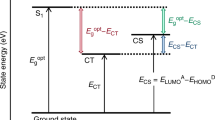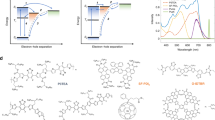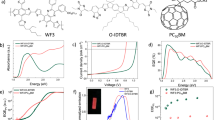Abstract
Interfaces between organic electron-donating (D) and electron-accepting (A) materials have the ability to generate charge carriers on illumination. Efficient organic solar cells require a high yield for this process, combined with a minimum of energy losses. Here, we investigate the role of the lowest energy emissive interfacial charge-transfer state (CT1) in the charge generation process. We measure the quantum yield and the electric field dependence of charge generation on excitation of the charge-transfer (CT) state manifold via weakly allowed, low-energy optical transitions. For a wide range of photovoltaic devices based on polymer:fullerene, small-molecule:C60 and polymer:polymer blends, our study reveals that the internal quantum efficiency (IQE) is essentially independent of whether or not D, A or CT states with an energy higher than that of CT1 are excited. The best materials systems show an IQE higher than 90% without the need for excess electronic or vibrational energy.
This is a preview of subscription content, access via your institution
Access options
Subscribe to this journal
Receive 12 print issues and online access
$259.00 per year
only $21.58 per issue
Buy this article
- Purchase on Springer Link
- Instant access to full article PDF
Prices may be subject to local taxes which are calculated during checkout




Similar content being viewed by others
References
Deibel, C. & Dyakonov, V. Polymer–fullerene bulk heterojunction solar cells. Rep. Prog. Phys. 73, 096401 (2010).
Riede, M., Mueller, T., Tress, W., Schueppel, R. & Leo, K. Small-molecule solar cells—status and perspectives. Nanotechnology 19, 424001 (2008).
Li, G., Zhu, R. & Yang, Y. Polymer solar cells. Nature Photon. 6, 153–161 (2012).
Arkhipov, V. I., Emelianova, E. V. & Bässler, H. Hot exciton dissociation in a conjugated polymer. Phys. Rev. Lett. 82, 1321–1324 (1999).
Tong, M., Coates, N. E., Moses, D., Heeger, A. J., Beaupré, S. & Leclerc, M. Charge carrier photogeneration and decay dynamics in the poly (2, 7-carbazole) copolymer PCDTBT and in bulk heterojunction composites with PC70BM. Phys. Rev. B 81, 125210 (2010).
Vandewal, K. et al. Quantification of quantum efficiency and energy losses in low bandgap polymer: Fullerene solar cells with high open-circuit voltage. Adv. Funct. Mater. 22, 3480–3490 (2012).
Hou, J., Chen, H.-Y., Zhang, S., Chen, R. I., Yang, Y., Wu, Y. & Li, G. Synthesis of a low band gap polymer and its application in highly efficient polymer solar cells. J. Am. Chem. Soc. 131, 15586 (2009).
Liang, Y. et al. For the bright future-bulk heterojunction polymer solar cells with power conversion efficiency of 7.4%. Adv. Mater. 22, E135–E138 (2010).
Park, S. H. et al. Bulk heterojunction solar cells with internal quantum efficiency approaching 100%. Nature Photon. 3, 297–302 (2009).
Lin, L-Y. et al. A donor–acceptor–acceptor molecule for vacuum-processed organic solar cells with a power conversion efficiency of 6.4%. Chem. Commun. 48, 1857–1859 (2012).
Bartelt, J. A. et al. The importance of fullerene percolation in the mixed regions of polymer–fullerene bulk heterojunction solar cells. Adv. Energy Mater. 3, 364–374 (2013).
Brédas, J. L., Norton, J. E., Cornil, J. & Coropceanu, V. Molecular understanding of organic solar cells: The challenges. Acc. Chem. Res. 42, 1691–1699 (2009).
Benson-Smith, J. J. et al. Formation of a ground-state charge-transfer complex in polyfluorene/[6, 6]-phenyl-c61 butyric acid methyl ester (PCBM) blend films and its role in the function of polymer/PCBM solar cells. Adv. Funct. Mater. 17, 451–457 (2007).
Loi, M. A. et al. Charge transfer excitons in bulk heterojunctions of a polyfluorene copolymer and a fullerene derivative. Adv. Funct. Mater. 17, 2111–2116 (2007).
Vandewal, K., Tvingstedt, K., Gadisa, A., Inganäs, O. & Manca, J. V. On the origin of the open-circuit voltage of polymer–fullerene solar cells. Nature Mater. 8, 904–909 (2009).
Ohkita, H. et al. Charge carrier formation in polythiophene/fullerene blend films studied by transient absorption spectroscopy. J. Am. Chem. Soc. 130, 3030–3042 (2008).
Bakulin, A. A. et al. The role of driving energy and delocalized states for charge separation in organic semiconductors. Science 335, 1340–1344 (2012).
Grancini, G. et al. Hot exciton dissociation in polymer solar cells. Nature Mater. 12, 29–33 (2013).
Kniepert, J., Schubert, M., Blakesley, J. C. & Neher, D. Photogeneration and recombination in P3HT/PCBM solar cells probed by time-delayed collection field experiments. J. Phys. Chem. Lett. 2, 700–705 (2011).
Albrecht, S. et al. On the field dependence of free charge carrier generation and recombination in blends of PCPDTBT/PC70BM: Influence of solvent additives. J. Phys. Chem. Lett. 3, 640–645 (2012).
Mihailetchi, V. D., Koster, L. J. A., Hummelen, J. C. & Blom, P. W. M. Photocurrent generation in polymer–fullerene bulk heterojunctions. Phys. Rev. Lett. 93, 216601 (2004).
Mingebach, M., Walter, S., Dyakonov, V. & Deibel, C. Direct and charge transfer state mediated photogeneration in polymer–fullerene bulk heterojunction solar cells. Appl. Phys. Lett. 100, 193302 (2012).
Parkinson, P., Lloyd-Hughes, J., Johnston, M. B. & Herz, L. M. Efficient generation of charges via below-gap photoexcitation of polymer–fullerene blend films investigated by terahertz spectroscopy. Phys. Rev. B 78, 115321 (2008).
Lee, J. et al. Charge transfer state versus hot exciton dissociation in polymer–fullerene blended solar cells. J. Am. Chem. Soc. 132, 11878–11880 (2010).
Van der Hofstad, T. G. J., Di Nuzzo, D., van den Berg, M., Janssen, R. A. J. & Meskers, S. C. J. Influence of photon excess energy on charge carrier dynamics in a polymer–fullerene solar cell. Adv. Energy Mater. 2, 1095–1099 (2012).
Würfel, P. The chemical potential of radiation. J. Phys. C 15, 3967–3985 (1982).
Würfel, P. The Physics of Solar Cells (Wiley, 2007).
Kasha, M. Characterization of electronic transitions in complex molecules. Discuss. Faraday Soc. 9, 14–19 (1950).
Lupton, J. M. Frequency up-conversion as a temperature probe of organic opto-electronic devices. Appl. Phys. Lett. 80, 186–188 (2002).
Gresser, R., Hummert, M., Hartmann, H., Leo, K. & Riede, M. Synthesis and characterization of near-infrared absorbing benzannulated Aza-BODIPY dyes. Chem. Eur. J. 17, 2939–2947 (2011).
Meiss, J., Holzmueller, F., Gresser, R., Leo, K. & Riede, M. Near-infrared absorbing semitransparent organic solar cells. Appl. Phys. Lett. 99, 193307 (2011).
Yin, C. et al. Tuning of the excited-state properties and photovoltaic performance in PPV-based polymer blends. J. Phys. Chem. C 112, 14607–14617 (2008).
Jailaubekov, A. E. et al. Hot charge-transfer excitons set the time limit for charge separation at donor/acceptor interfaces in organic photovoltaics. Nature Mater. 12, 66–73 (2013).
Acknowledgements
This publication was supported by the Center for Advanced Molecular Photovoltaics (Award No KUS-C1-015-21) and the Department of Energy, Laboratory Directed Research and Development funding, under contract DE-AC02-76SF00515. The PCDTBT used in this work was provided by St-Jean Photochemicals. M.K.R. acknowledges financial support by the BMBF through project 03IP602 and J.W. acknowledges support from the Heinrich-Böll-Stiftung. S.A. and M.S. acknowledge financial support by the BMBF within PVcomB (FKZ 03IS2151D) and the DFG (SPP 1355). D.N. thanks the DFG for financially supporting a travel grant. K.R.G. and A.A. acknowledge SABIC for a post-doctoral fellowship. The authors thank J. Kurpiers for technical assistance with the TDCF set-up.
Author information
Authors and Affiliations
Contributions
K.V., D.N., S.A. and A. Salleo designed the experiments. S.A. prepared devices for TDCF experiments and performed the TDCF experiments. K.V., W.R.M., E.T.H., K.R.G., J.T.B., M.S., J.W. and M.K.R. prepared photovoltaic devices and optimized their processing parameters for photovoltaic performance. E.T.H. and J.T.B. adjusted the EQE and electroluminescence measurement set-ups for the detection of weak signals, crucial for this work. K.V., E.T.H. and K.R.G. measured the EQE and electroluminescence spectra. K.V. measured the PDS spectra. J.D.D. synthesized PBDTTPD. A. Sellinger, J.M.J.F., A.A., M.K.R. and M.D.M. supervised their team members involved in the project. D.N. and A. Salleo supervised the overall project. All authors contributed to analysis and writing.
Corresponding authors
Ethics declarations
Competing interests
The authors declare no competing financial interests.
Supplementary information
Supplementary Information
Supplementary Information (PDF 1308 kb)
Rights and permissions
About this article
Cite this article
Vandewal, K., Albrecht, S., Hoke, E. et al. Efficient charge generation by relaxed charge-transfer states at organic interfaces. Nature Mater 13, 63–68 (2014). https://doi.org/10.1038/nmat3807
Received:
Accepted:
Published:
Issue Date:
DOI: https://doi.org/10.1038/nmat3807
This article is cited by
-
Physical insights into non-fullerene organic photovoltaics
Nature Reviews Physics (2024)
-
Reduced bimolecular charge recombination in efficient organic solar cells comprising non-fullerene acceptors
Scientific Reports (2023)
-
Suppressing electron-phonon coupling in organic photovoltaics for high-efficiency power conversion
Nature Communications (2023)
-
Driving force and nonequilibrium vibronic dynamics in charge separation of strongly bound electron–hole pairs
Communications Physics (2023)
-
Hole utilization in solar hydrogen production
Nature Reviews Chemistry (2022)



